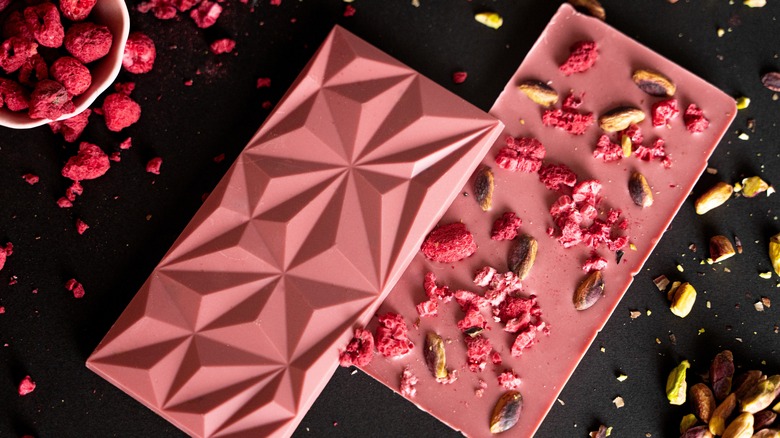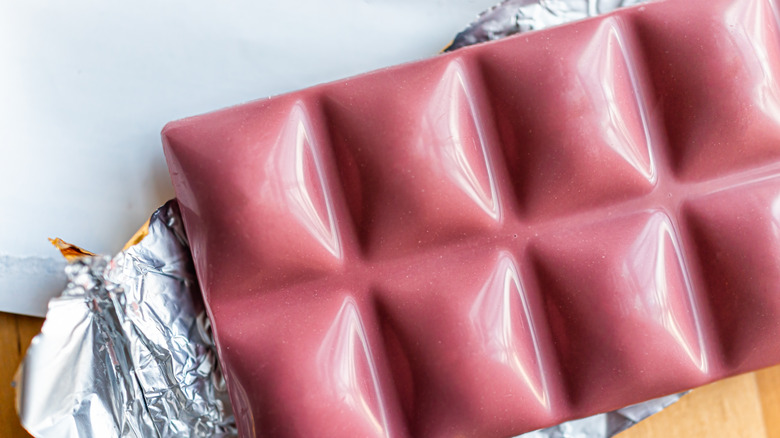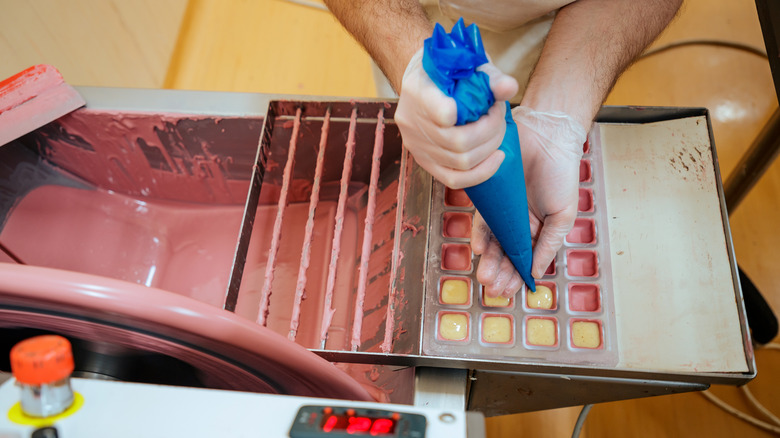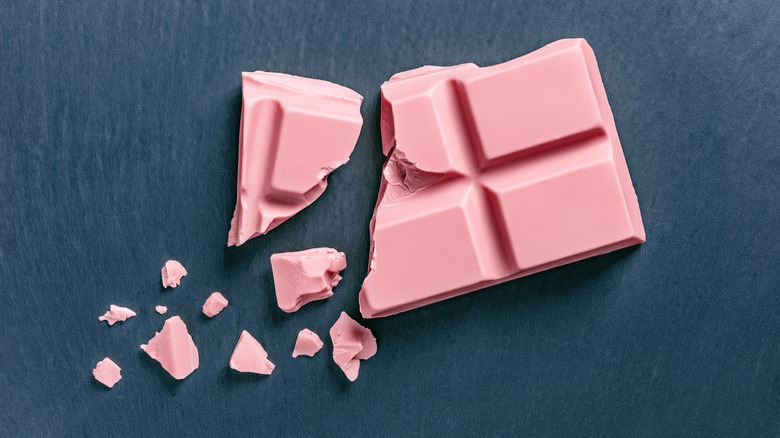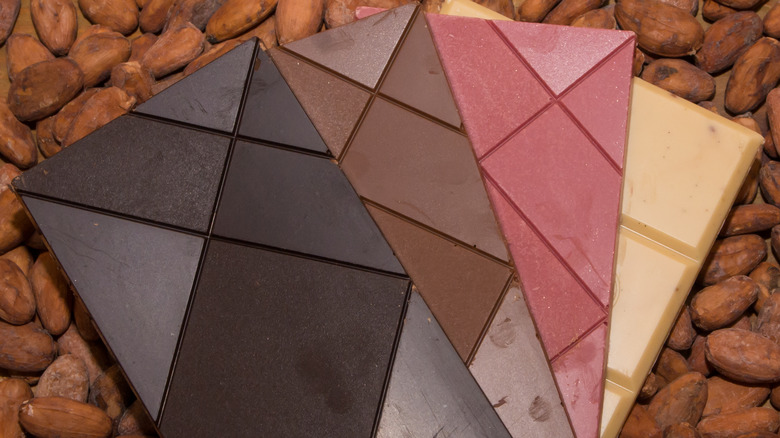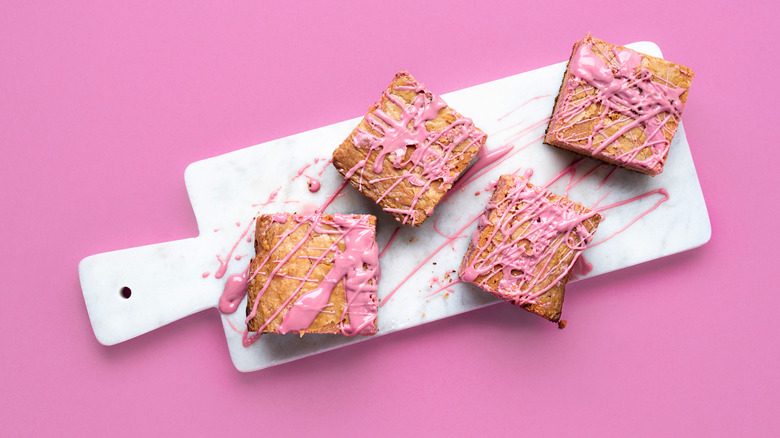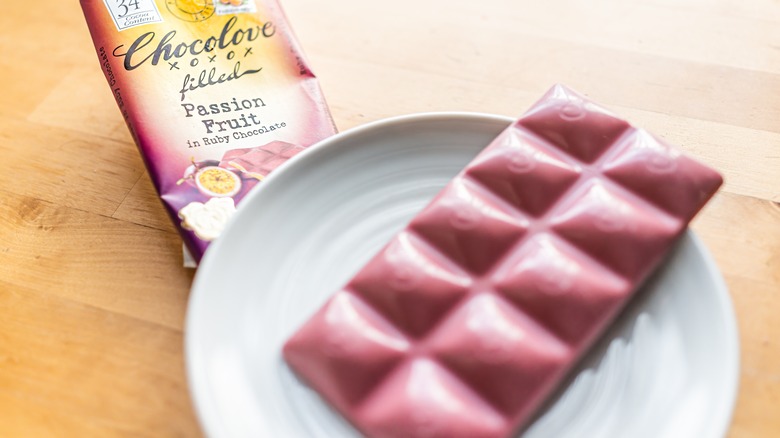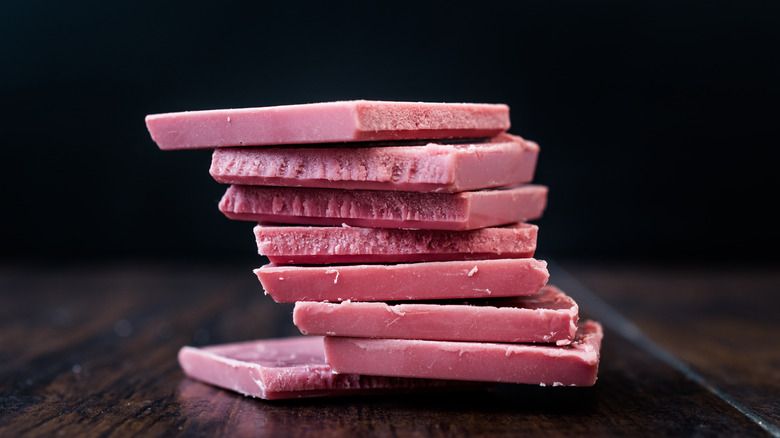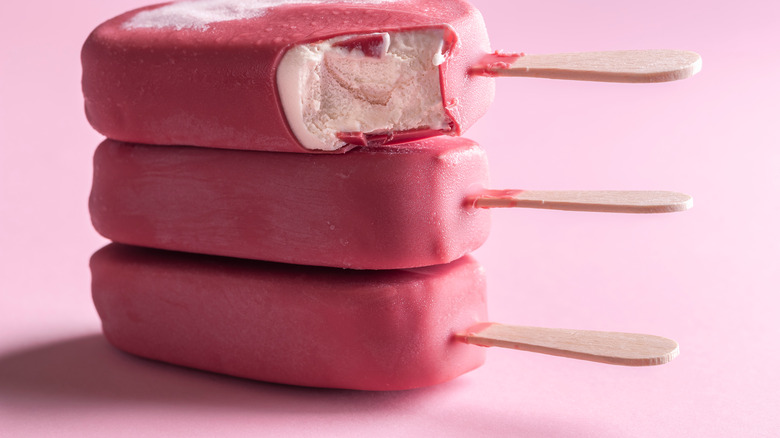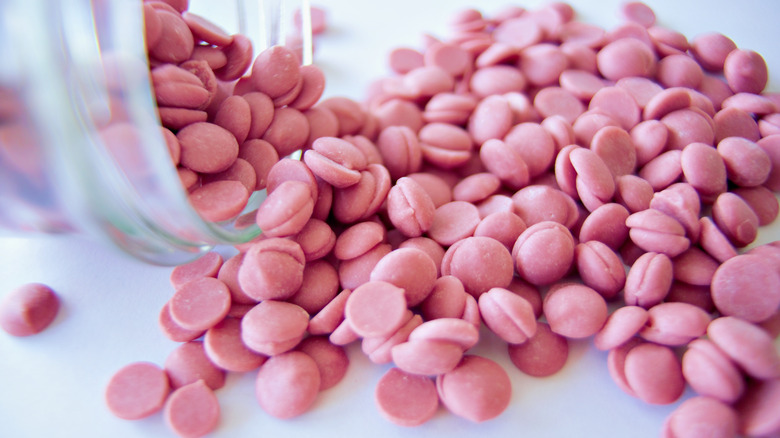Ruby Chocolate Is The Perfect Treat For Fruit Lovers
We may receive a commission on purchases made from links.
Chocolate is delicious in nearly every way it comes. Most people are familiar with dark chocolate, milk chocolate, and white chocolate. But, the chocolate family has a unique fourth member that is certainly lesser known: ruby chocolate. This rosy-colored chocolate is eye-catching in desserts and confections and has a distinct flavor that other chocolates can't replicate. And, it carries an air of mystery in the chocolate world — the company that released it to the market has patented the recipe and kept it a trade secret.
To get the details on the latest star of the chocolate world, we consulted the chocolatier and owner of Delysia Chocolatier, Nicole Patel. She's been crafting chocolates and confections at her Austin, Texas-based business since 2008 and she was named 2023's Best Chocolatier and Confectioner in the Americas by the International Chocolate Salon Awards and Taste TV. Patel uses ruby chocolate in various recipes including truffles and wine-pairing kits.
We used Patel's expert advice and researched the ruby chocolate market to answer questions about its flavors, nutritional value, and how it stacks up to other chocolates. Chocolate recipes, blog posts, and the information provided by ruby chocolate producers also informed us about this sweet treat. From how it's made, and how to pair it with wines, to storing it, this guide has everything you need to know about ruby chocolate.
What is Ruby Chocolate?
Ruby chocolate is mostly known for its vibrant, light pink hue and subtle fruity flavor profile. The coloring, derived from ruby cacao beans, makes the chocolate visually appealing and also plays a part in the unique flavor. Chocolate company Barry Callebaut released ruby chocolate to markets in 2017 and had been reportedly experimenting with its recipes since 2004. Nicole Patel says, "Ruby chocolate was the first new style of authentic chocolate since white chocolate debuted in the 1930s."
The chocolate comes in baking chips and bars but shines when added as an ingredient to other goodies like truffles, cheesecakes, and baked goods. It also gained some popularity with the millennial pink trend that took over social media in the 2010s when platform creators, typically of the millennial generation, championed a dusty pink color. Patel added, "Its striking hue is all-natural, derived directly from the cacao beans, with no added colors or flavorings."
How Is Ruby Chocolate Made?
Less is known about ruby chocolate's production process than other chocolate varieties partly because its creator, Barry Callebaut, has patented the recipe, and the exact production details are considered a trade secret. The company says the special ruby-colored cocoa beans used for ruby chocolate are grown in Ecuador, Brazil, and the Ivory Coast. After the beans are harvested, they undergo fermentation, temperature treatment, and conching time. And, in any chocolate-making process, after the cocoa beans are fermented and roasted, they are turned into liquor and mixed with ingredients like sugar and milk to produce the final product.
There is some debate about whether the pink color comes from a specifically sourced cocoa bean variety or simply a pause in the fermentation process. Some speculate that the manufacturer stops the fermentation stage of their cocoa beans and treats them with an acid to produce the signature ruby hue. Nicole Patel explains, "By foregoing the conventional steps of fermentation and roasting [...] a distinct tart, blush-pink chocolate with an innate sweetness is created."
Barry Callebaut says that ruby chocolate's fruity flavors and color are 100% natural with no artificial dyes or additives mixed into the chocolate. They add that the production of ruby chocolate cannot be called natural because the process does not occur independently in nature and requires chocolate makers to interfere using their production methods and other ingredients.
What does ruby chocolate taste like?
Ruby chocolate has a flavor as unique and exciting as its vibrant color. Many compare its sweet and tart flavor to raspberries or strawberries and therefore perfect for those wanting a fruity burst with their treat. And, its creamy, smooth, and indulgent texture is similar to milk chocolate. Nicole Patel explains, "[the] delightful fusion of both sweet and sour elements, [is] like sweetened raspberry-infused milk."
Ruby chocolate's profile pairs nicely with complimentary flavors like sweet berries and fruit as well as warmer, more contrasting flavors. Patel adds, "The natural fruitiness of ruby chocolate can be elevated by incorporating fresh raspberries or strawberries, intensifying the vibrant, tart undertones. On the contrary, a dash of chipotle peppers may be employed to introduce a contrasting layer, subtly taming the tart notes and adding an intriguing depth to the overall flavor profile."
Wine is a great partner to ruby chocolate, but choosing the right one is essential for the most flavorful experience possible. Patel recommends a sparkling rosé or berry-focused pinot noir or Beaujolais for a complimentary pairing that will emphasize the fruity flavors in ruby chocolate. A contrasting pairing would balance out the fruitiness of the chocolate and a rich cabernet sauvignon would be the right choice.
Ruby chocolate vs. regular chocolate?
Other than ruby chocolate, there are three different basic types of chocolate: dark, milk, and white – each with its own set of regulations as laid out by the Food and Drug Administration. And, the FDA also has rules determining what constitutes authentic ruby chocolate. It must have at least 1.5% nonfat cacao solids, 20% cacao fat, 2.5% milk fat, and 12% total milk solids.
By comparison, the FDA regulations state that dark chocolate – referred to as bittersweet or semisweet — must contain at least 35% cocoa solids. And, this variety does not typically have added milk solids, giving it the most bitter taste out of all the chocolate varieties.
Milk chocolate has a similar creamy and smooth texture to ruby chocolate and is the go-to for commercial candy bars. The FDA regulates that this variety must contain at least 10% cocoa solids, 3.39% milk fat, and 12% milk solids. Milk chocolate is the most similar to ruby chocolate although much sweeter and lacks the fruity complexities.
White chocolate is another sweet and smooth variety made from the butter of the cocoa bean, giving it its distinct milky color. It must contain at least 20% cocoa butter, 14% of total milk solids, and 3.5% milk fat. It can also contain a maximum of 55% nutritive carbohydrate sweeteners (basically sugar), according to the FDA. It tends to have a more one-dimensional sweetness and is used in similar confections to ruby chocolate.
How to cook with ruby chocolate
Ruby chocolate is a stunning visual addition to baked goods and confections and adds depth with its signature flavor profile. "In a delectable chocolate cheesecake swirl, the vibrant hue and unique flavor of ruby chocolate can be swirled into the creamy batter, offering a visually stunning and delicious twist on a classic dessert," says Nicole Patel.
Barry Callebaut says that when using ruby chocolate as an ingredient, special considerations should be taken. It is not a stable product, and it pairs better in confections and with fat-based techniques like chocolates, and nuts, or mixed into cookies and cakes. It is temperamental when used in water-based techniques because the full flavors of the chocolate may diminish with exposure to moisture.
Barry Callebaut also recommends pairing it with cheeses like Gorgonzola and Roquefort. It also says nuts and seeds like pistachios, almonds, pumpkin seeds, and cashews can make a delicious combination with ruby chocolate.
Where can you buy ruby chocolate?
Ruby chocolate market availability is more limited than other chocolate varieties. Most ruby chocolate products are in bar form but Barry Callebaut sells chips and disks of ruby chocolate and most likely sells the highest quality product since it owns the patent.
For those wanting a straight-up chocolate bar without necessarily preparing it for dessert, there's the Chocolove Ruby Chocolate Bar. It contains 34% cocoa and is sold through multiple online retailers, like Amazon, or in certain independent chocolate shops.
Ruby chocolate can also be purchased as part of a larger delicacy. Chocolatiers, confection makers, and pastry chefs may sell goods like truffles or mousse made with ruby chocolate. Ruby hot chocolate and ruby chocolate-drenched Oreos are just two inventive ways companies use ruby chocolate. In 2018, a ruby chocolate KitKat bar was released in the United Kingdom but has since been discontinued.
Nutritional information about ruby chocolate
The Chocolove Ruby Chocolate Bar contains three 29-gram servings (a total of 87 grams in each bar). And, each bar contains 480 calories, 45 grams of carbohydrates, 30 grams of fat, and 9 grams of protein. The ingredients are simply sugar, cocoa butter, milk, cocoa liquor, soy lecithin, citric acid, and vanilla. The Barry Callebaut ingredient list contains sugar, cocoa butter, nonfat dry milk, whole milk powder, unsweetened chocolate, lecithin (soy); citric acid, and natural vanilla flavor. A typical 100 grams of this chocolate contains 317 calories, 9.3 grams of protein, 35.9 grams of fat, and 51.6 grams of carbohydrates.
In addition, the FDA's regulations establish that no artificial flavors or colors can be included in a recipe if it aims to be genuine ruby chocolate. In 2019, the FDA announced that ruby chocolate following the updated guidelines could be considered "genuine chocolate" like dark, milk, and white chocolates. And, it can have no more than 1.5% emulsifying agents, and 5% of whey or whey products.
Varieties of Ruby Chocolate
Small chocolatier businesses and large companies have found ways to incorporate ruby chocolate into different products. Several make their chocolate bars available for purchase online or in storefronts. Amy's Candy Bar sells ruby chocolate bars with a freeze-dried strawberry topping that heightens the berry flavors of the chocolate. Tru Fru is a frozen dessert brand available at Target and offers frozen strawberries with a ruby chocolate coating. Other companies get more creative with marketing ruby chocolate. Ice cream brand Häagen-Dazs released their limited edition Ruby Cacao Crackle Ice Cream in 2020 but it has since been discontinued.
One thing to be mindful of is how ruby chocolate could sometimes be inaccurately marketed. Businesses may use misleading messages to sell products that don't meet the standards of ruby chocolate production. Products with the same color as ruby chocolate may be white chocolate with pink dyes added. Milk chocolates and dark chocolate products with a berry filling also don't fit the criteria. It is best to look at the label for any artificial dyes, flavorings, or ingredients, indicating the product is something other than ruby chocolate.
How to store Ruby Chocolate
Storing any chocolate can be a headache. It melts in the heat, hardens too much in the cold, and is generally a temperamental ingredient. Ruby chocolate operates in the same ways other chocolate does, so storing it properly is essential to maintain the integrity of the flavors and texture. It is ideal to store ruby chocolate in an opaque and airtight container.
It is sensitive to oxygen, moisture, and light exposure, so a reusable plastic container or sealed bag will work best. When ruby chocolate is exposed to intense light, the rosy color may dull into a dusty, greyish pink that does not look as delicious. Storing ruby chocolate in the fridge will cause it to harden and lose its textural integrity. Keeping it in a dry, cool pantry is ideal. Ruby chocolate has a year-long shelf life if left unopened from its container. However, after eight months, it may lose its distinct tart and berry-like flavor.
Methodology
We combed the internet to find all the information chocolate lovers need. We read guides written by ruby chocolate producers about their recipes and production methods. We consulted reviews and the FDA's guidelines for ruby chocolate to vet the flavor and nutritional information. In addition to this research, Nicole Patel provided essential insight into cooking with ruby chocolate and pairing it with other delicacies.
